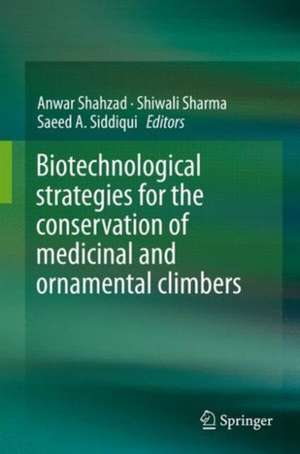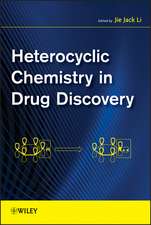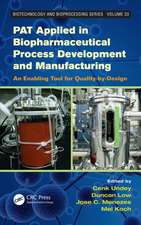Biotechnological strategies for the conservation of medicinal and ornamental climbers
Editat de Anwar Shahzad, Shiwali Sharma, Saeed A. Siddiquien Limba Engleză Hardback – 5 ian 2016
| Toate formatele și edițiile | Preț | Express |
|---|---|---|
| Paperback (1) | 801.73 lei 38-45 zile | |
| Springer International Publishing – 29 mar 2018 | 801.73 lei 38-45 zile | |
| Hardback (1) | 968.96 lei 3-5 săpt. | |
| Springer International Publishing – 5 ian 2016 | 968.96 lei 3-5 săpt. |
Preț: 968.96 lei
Preț vechi: 1181.66 lei
-18% Nou
Puncte Express: 1453
Preț estimativ în valută:
185.45€ • 192.86$ • 155.18£
185.45€ • 192.86$ • 155.18£
Carte disponibilă
Livrare economică 21 februarie-07 martie
Preluare comenzi: 021 569.72.76
Specificații
ISBN-13: 9783319192871
ISBN-10: 3319192876
Pagini: 450
Ilustrații: XIV, 506 p. 25 illus., 1 illus. in color.
Dimensiuni: 155 x 235 x 34 mm
Greutate: 1.12 kg
Ediția:1st ed. 2016
Editura: Springer International Publishing
Colecția Springer
Locul publicării:Cham, Switzerland
ISBN-10: 3319192876
Pagini: 450
Ilustrații: XIV, 506 p. 25 illus., 1 illus. in color.
Dimensiuni: 155 x 235 x 34 mm
Greutate: 1.12 kg
Ediția:1st ed. 2016
Editura: Springer International Publishing
Colecția Springer
Locul publicării:Cham, Switzerland
Public țintă
ResearchCuprins
1: Climbers: Evolution and Diversification in Angiosperm
1.1 Introduction
1.2 Climbing habitat
1.3 Climbing and attachment mechanisms
1.4 Types of climber
1.5 General taxonomy of climbing plants
1.6 Some general properties of climbing plants
1.7 Role of climbers in ecosystem
1.8 Climber’s evolution
1.9 How long ago were climbing plants common in forested ecosystems?
2: Biodiversity Conservation with Special Reference to Medicinal Climbers: Present Scenario, Challenges, Strategies and Policies
2.1 Biodiversity: Natural Capital of The Earth
2.2 Types of Biodiversity (Diversity Indices)
2.3 Levels of Biodiversity
2.4 The Mega Diversity Regions
2.5 Hotspots of Biodiversity
2.6 Loss of Biodiversity
2.7 Threats to Biodiversity: Causes
2.8 IUCN Threat Categories
2.9 IUCN Threat Criteria
2.10 Market Scenario for Medicinal Plant
2.11 Loss of Biodiversity and Challenges
2.12 Climbing Phytodiversity in India
2.13 List of Climbers (Medicinal and Ornamental) Facing Threat
2.14 Global Strategy for Biodiversity Conservation
2.15 Strategies Used for Biodiversity Conservation
2.16 Policies for Biodiversity Conservation 3: Medicinal Importance of Climbers Used In Unani System of Medicine
3.1 Introduction
3.2 Ghonghchi
3.3 Zaravand Taweel
3.4 Zaravand Modahraj
3.5
Satavar
3.6 Asfanakh
3.7 Habb-ul-Qiliqil
3.8 Malkangani
3.9 Hadjod
3.10 Hirankhur
3.11 ftimun Vilayati
3.12 Baobarang/Barang Kabuli
3.13 Gurmaar Booti
3.14 Ushba Hindi
3.15 Turbud
3.16 Bandaal
3.17 Karela
3.18 Konch
3.19 Paan
3.20 Kabab Chini/Kababah
3.21 Filfil Seyah
3.22 Gilo
3.23 Maweez 4: Climber Plants: Medicinal Importance and Conservation Strategies
4.1 Introduction
4.2 History
4.3 Habitat and Distribution
4.4 Medicinal Application and Drug Discovery
4.5 Threats
4.6 Conservation Strategies
4.7 Role of Biotechnology on Their Conservation
4.8 Some Selected Climbing Plant Families
4.9 Conclusion
5: Plant Tissue Culture: Profile of Pioneers
5.1 Introduction
5.2 History of Plant Tissue Culture
5.3 Profile of Pioneers
6: Mircopropagation: A Boon for Conservation of Valuable Vines and Lianas
6.1 Introduction
6.2
Basic Plant Tissue Culture Techniques
6.3 Steps of Culturing Plant Tissue
6.4 Development of Nutrient Media
6.5 Advantages of Micropropagation Over Conventional Cultivation
6.6 Drawbacks of Plant Tissue Culture
6.7 Micropropagation Protocols For Some Threatened And Endangered Medicinal Lianas
6.8 Future Prospects 7: Somatic Embryogenesis: A Valuable Strategy for Phyto-Climbing Diversity Conservation
7.1 Introduction
7.2 Terminology
7.3 Zygotic embryogenesis versus somatic embryogenesis
7.4 Different phases of somatic embryogenesis
7.5 Factors affecting somatic embryogenesis
7.6 Important genes related to somatic embryogenesis
7.7 Applications of somatic
embryogenesis
7.8 Limitations of somatic embryogenesis
7.9 Types of somatic embryogenesis
7.10 Somatic embryogenesis in medicinal climbers
7.11 Future prospects
8: Biotechnological Perspectives towards Improvement of Decalepishamiltonii, Potential Applications of Its tubers And Bioactive Compounds of Nutraceuticals for Value Addition
8.1 Introduction
8.2 Ethnobotanical information
8.3 Production
8.4 Phytoconstituents of tubers
8.5 Biotechnological intervention for mass multiplication
8.6 Germination studies
8.7 In vitro propagation methods
8.8 In vitro production of flavour metabolite 2H4MB
8.9 Augmentation of flavour metabolite in tubers
8.10 Applications of tubers
8.11 Other applications
8.12 Insecticidal activity
8.13 Antimicrobial activity
8.14 Medicinal applications
8.15 Bioactivity studies in cell cultures and experimental animals
8.16
Future prospects 9: Tylophora indica (Burm. f.) Merrill: Medicinal Uses, Propagation and Replenishment
9.1 Introduction: Vernacular Names, Habitat, Habit, Taxonomy
9.2 Chemical Constituents
9.3 Medicinal Properties
9.4 Plant Tissue Culture Studies
10: In Vitro Strategies for the Conservation of Some Medicinal and Horticultural Climbers
10.1 Introduction
10.1.1 Cardiospermumhalicacabum Linn
10.1.2 BenincasahispidaCogn.
10.1.3. TylophoraindicaBurm. f. Merrill.
10.1.4 SarcostemmabrevistigmaWight.
10.1.5 CycleapeltataLam.
10.1.6 Caesalpiniabonduc (L.)Roxb.
10.1.7 Clitoriaternatea L.
10.1.8 HemidesmusindicusL. R. Br.
10.1.9 Momordicacharantia L.
10.1.10
EmbeliaribesBurm F.
11: Advancement in Encapsulation Techniques for Conservation of Climbers
11.1 Introduction
11.2 Advantages of Synthetic Seed Technology
11.3 Encapsulation Procedure
11.4 Studies Conducted So Far for Synthetic Seed Production of Woody Climbers
11.5 Concluding Remarks and Future Prospects
12: Secondary Metabolite Enhancement in Medicinal Climbers through the Intervention of Abiotic and Biotic Elicitors
12.1 Introduction
12.2 Classification of elicitors
12.3 Mechanism of Elicitation: the biochemical pathway
12.4 Elicitors: Effect and Outcome in Enhanced Alkaloid Production 13: Basic Principles behind Genetic Transformation in Plants
13.1 Introduction
13.2 Methods of Genetic Transformation
13.3 Gene Expression in Transgenic Plants
13.4 Engineering Plants for Useful Agronomic Traits
13.5 Future Implications of Plant Transformation
13.6 Conclusion 14: Genetic Transformation for Quality Improvement of Ornamental Climbers
14.1 Introduction
14.2 Type Study
14.3 Future Prospects
14.3 Conclusion
15: Advances in Molecular Approaches for the Integrative Genetic Transformation of Highly Important Climbers
15.1 Introduction
15.2 Future Prospects and Conclusion
16: Molecular Markers and their Applications in Plant Biotechnology
16.1 Molecular Markers: An Introduction
16.2 Restriction Fragment Length Polymorphism (RFLP)
16.3 Randomly Amplified Polymorphic DNA Markers (RAPD)
16.4 Amplified Fragment Length Polymorphism (AFLP)
16.5 Inter Simple Sequence
Repeats (ISSR)
16.6 Minisatellites, Variable Number of Tandem Repeats (VNTR)
16.7 Microsatellites or Simple Sequence Repeat (SSR)
16.8 Single-Strand Conformation Polymorphism (SSCP)16.9 Cleaved Amplified Polymorphic Sequence (CAPS)
16.11 Single Nucleotide Polymorphism (SNP)
16.12 Sequence-Specific Amplified Polymorphism (S-SAP)
16.13 DNA amplification fingerprinting (DAF)
16.14 Arbitrary primed polymerase chain reaction (AP-PCR)
16.15 Interretrotransposon Amplified Polymorphism (IRAP) and Retrotransposon- Microsatellite Amplified Polymorphism (REMAP)
16.16 Retrotransposon-Based Insertional Polymorphism (RBIP)
16.17 Applications of Molecular Markers In Plant Genome Analysis and Breeding
16.18 Conclusions
16.19 Future Prospects17: Use of MolecularMarkers in Medicinal Climber
17.1 Introduction
17.2 Application of Molecular Markers in Genetic Studies of Some Important Medicinal Climbers
17.3 Conclusions
17.4 Future prospects 18: Selective Protocols for In Vitro Propagation of Threatened Medicinal Climbers
18.1 Introduction
18.2 Climber
18.3 Importance of Ornamental Plants
18.4 Plant Tissue Culture
18.5 Advancement in Production of Secondary Metabolites via Plant Tissue Culture
18.6 Conclusions
19: In Vitro Protocols for Ornamental Climbers
19.1 Introduction
19.2 Type Studies
19.3 Concluding Remarks and Future Prospects
20: Contribution of Biotechnology in the Enhancement of Secondary Metabolites in Selected Medicinal Climbers
20.1 Introduction
20.2 Biotechnological Tools
20.3 Medicinal Climbers and Use of Biotechnological
Tools
20.4 Future Prospects for Improvement of Important Bioactive Molecules of Medicinal Climbers
20.6 Conclusions
1.1 Introduction
1.2 Climbing habitat
1.3 Climbing and attachment mechanisms
1.4 Types of climber
1.5 General taxonomy of climbing plants
1.6 Some general properties of climbing plants
1.7 Role of climbers in ecosystem
1.8 Climber’s evolution
1.9 How long ago were climbing plants common in forested ecosystems?
2: Biodiversity Conservation with Special Reference to Medicinal Climbers: Present Scenario, Challenges, Strategies and Policies
2.1 Biodiversity: Natural Capital of The Earth
2.2 Types of Biodiversity (Diversity Indices)
2.3 Levels of Biodiversity
2.4 The Mega Diversity Regions
2.5 Hotspots of Biodiversity
2.6 Loss of Biodiversity
2.7 Threats to Biodiversity: Causes
2.8 IUCN Threat Categories
2.9 IUCN Threat Criteria
2.10 Market Scenario for Medicinal Plant
2.11 Loss of Biodiversity and Challenges
2.12 Climbing Phytodiversity in India
2.13 List of Climbers (Medicinal and Ornamental) Facing Threat
2.14 Global Strategy for Biodiversity Conservation
2.15 Strategies Used for Biodiversity Conservation
2.16 Policies for Biodiversity Conservation 3: Medicinal Importance of Climbers Used In Unani System of Medicine
3.1 Introduction
3.2 Ghonghchi
3.3 Zaravand Taweel
3.4 Zaravand Modahraj
3.5
Satavar
3.6 Asfanakh
3.7 Habb-ul-Qiliqil
3.8 Malkangani
3.9 Hadjod
3.10 Hirankhur
3.11 ftimun Vilayati
3.12 Baobarang/Barang Kabuli
3.13 Gurmaar Booti
3.14 Ushba Hindi
3.15 Turbud
3.16 Bandaal
3.17 Karela
3.18 Konch
3.19 Paan
3.20 Kabab Chini/Kababah
3.21 Filfil Seyah
3.22 Gilo
3.23 Maweez 4: Climber Plants: Medicinal Importance and Conservation Strategies
4.1 Introduction
4.2 History
4.3 Habitat and Distribution
4.4 Medicinal Application and Drug Discovery
4.5 Threats
4.6 Conservation Strategies
4.7 Role of Biotechnology on Their Conservation
4.8 Some Selected Climbing Plant Families
4.9 Conclusion
5: Plant Tissue Culture: Profile of Pioneers
5.1 Introduction
5.2 History of Plant Tissue Culture
5.3 Profile of Pioneers
6: Mircopropagation: A Boon for Conservation of Valuable Vines and Lianas
6.1 Introduction
6.2
Basic Plant Tissue Culture Techniques
6.3 Steps of Culturing Plant Tissue
6.4 Development of Nutrient Media
6.5 Advantages of Micropropagation Over Conventional Cultivation
6.6 Drawbacks of Plant Tissue Culture
6.7 Micropropagation Protocols For Some Threatened And Endangered Medicinal Lianas
6.8 Future Prospects 7: Somatic Embryogenesis: A Valuable Strategy for Phyto-Climbing Diversity Conservation
7.1 Introduction
7.2 Terminology
7.3 Zygotic embryogenesis versus somatic embryogenesis
7.4 Different phases of somatic embryogenesis
7.5 Factors affecting somatic embryogenesis
7.6 Important genes related to somatic embryogenesis
7.7 Applications of somatic
embryogenesis
7.8 Limitations of somatic embryogenesis
7.9 Types of somatic embryogenesis
7.10 Somatic embryogenesis in medicinal climbers
7.11 Future prospects
8: Biotechnological Perspectives towards Improvement of Decalepishamiltonii, Potential Applications of Its tubers And Bioactive Compounds of Nutraceuticals for Value Addition
8.1 Introduction
8.2 Ethnobotanical information
8.3 Production
8.4 Phytoconstituents of tubers
8.5 Biotechnological intervention for mass multiplication
8.6 Germination studies
8.7 In vitro propagation methods
8.8 In vitro production of flavour metabolite 2H4MB
8.9 Augmentation of flavour metabolite in tubers
8.10 Applications of tubers
8.11 Other applications
8.12 Insecticidal activity
8.13 Antimicrobial activity
8.14 Medicinal applications
8.15 Bioactivity studies in cell cultures and experimental animals
8.16
Future prospects 9: Tylophora indica (Burm. f.) Merrill: Medicinal Uses, Propagation and Replenishment
9.1 Introduction: Vernacular Names, Habitat, Habit, Taxonomy
9.2 Chemical Constituents
9.3 Medicinal Properties
9.4 Plant Tissue Culture Studies
10: In Vitro Strategies for the Conservation of Some Medicinal and Horticultural Climbers
10.1 Introduction
10.1.1 Cardiospermumhalicacabum Linn
10.1.2 BenincasahispidaCogn.
10.1.3. TylophoraindicaBurm. f. Merrill.
10.1.4 SarcostemmabrevistigmaWight.
10.1.5 CycleapeltataLam.
10.1.6 Caesalpiniabonduc (L.)Roxb.
10.1.7 Clitoriaternatea L.
10.1.8 HemidesmusindicusL. R. Br.
10.1.9 Momordicacharantia L.
10.1.10
EmbeliaribesBurm F.
11: Advancement in Encapsulation Techniques for Conservation of Climbers
11.1 Introduction
11.2 Advantages of Synthetic Seed Technology
11.3 Encapsulation Procedure
11.4 Studies Conducted So Far for Synthetic Seed Production of Woody Climbers
11.5 Concluding Remarks and Future Prospects
12: Secondary Metabolite Enhancement in Medicinal Climbers through the Intervention of Abiotic and Biotic Elicitors
12.1 Introduction
12.2 Classification of elicitors
12.3 Mechanism of Elicitation: the biochemical pathway
12.4 Elicitors: Effect and Outcome in Enhanced Alkaloid Production 13: Basic Principles behind Genetic Transformation in Plants
13.1 Introduction
13.2 Methods of Genetic Transformation
13.3 Gene Expression in Transgenic Plants
13.4 Engineering Plants for Useful Agronomic Traits
13.5 Future Implications of Plant Transformation
13.6 Conclusion 14: Genetic Transformation for Quality Improvement of Ornamental Climbers
14.1 Introduction
14.2 Type Study
14.3 Future Prospects
14.3 Conclusion
15: Advances in Molecular Approaches for the Integrative Genetic Transformation of Highly Important Climbers
15.1 Introduction
15.2 Future Prospects and Conclusion
16: Molecular Markers and their Applications in Plant Biotechnology
16.1 Molecular Markers: An Introduction
16.2 Restriction Fragment Length Polymorphism (RFLP)
16.3 Randomly Amplified Polymorphic DNA Markers (RAPD)
16.4 Amplified Fragment Length Polymorphism (AFLP)
16.5 Inter Simple Sequence
Repeats (ISSR)
16.6 Minisatellites, Variable Number of Tandem Repeats (VNTR)
16.7 Microsatellites or Simple Sequence Repeat (SSR)
16.8 Single-Strand Conformation Polymorphism (SSCP)16.9 Cleaved Amplified Polymorphic Sequence (CAPS)
16.11 Single Nucleotide Polymorphism (SNP)
16.12 Sequence-Specific Amplified Polymorphism (S-SAP)
16.13 DNA amplification fingerprinting (DAF)
16.14 Arbitrary primed polymerase chain reaction (AP-PCR)
16.15 Interretrotransposon Amplified Polymorphism (IRAP) and Retrotransposon- Microsatellite Amplified Polymorphism (REMAP)
16.16 Retrotransposon-Based Insertional Polymorphism (RBIP)
16.17 Applications of Molecular Markers In Plant Genome Analysis and Breeding
16.18 Conclusions
16.19 Future Prospects17: Use of MolecularMarkers in Medicinal Climber
17.1 Introduction
17.2 Application of Molecular Markers in Genetic Studies of Some Important Medicinal Climbers
17.3 Conclusions
17.4 Future prospects 18: Selective Protocols for In Vitro Propagation of Threatened Medicinal Climbers
18.1 Introduction
18.2 Climber
18.3 Importance of Ornamental Plants
18.4 Plant Tissue Culture
18.5 Advancement in Production of Secondary Metabolites via Plant Tissue Culture
18.6 Conclusions
19: In Vitro Protocols for Ornamental Climbers
19.1 Introduction
19.2 Type Studies
19.3 Concluding Remarks and Future Prospects
20: Contribution of Biotechnology in the Enhancement of Secondary Metabolites in Selected Medicinal Climbers
20.1 Introduction
20.2 Biotechnological Tools
20.3 Medicinal Climbers and Use of Biotechnological
Tools
20.4 Future Prospects for Improvement of Important Bioactive Molecules of Medicinal Climbers
20.6 Conclusions
Textul de pe ultima copertă
Since time immemorial human beings are utilizing plants, apart from food and shelter, as medicine to cure ailments and ornamentals as aesthetic value. The recognized plants for medicinal uses mostly belong to tree, shrub and herbs, but there is another group of plants categorized as “CLIMBERS”. The climbing habit is a key innovation in angiosperms evolution. Climbing plant taxa have greater species richness than their non-climbing sister groups. Although it is considered as highly diversified clades but a much neglected group of the plants. In contrast with either erect or prostrate species, which occupy a narrow range of the light, climbers may use a very broad range of light availability. With the occupation of such an expanded ecological niche-ranging from forest floor to understory to forest canopy- a greater exposure to different pollinator, fruit/seed dispersers and herbivores would be granted. Almost one-third of the plant families includes climbers and contributes significantly to the function of any forest system.
Climbers are not well investigated by the researchers, however considerable information has been gathered in this book, which delineates for the researchers and readers to exploit medicinal and ornamental climbers for their benefit. As concerted efforts have not been made to popularize climbers for medicinal and aesthetic uses, the contributions made in this book will provide a platform to move ahead for better utilization of climbers in the service of human beings. This book offers an insightful look on different biotechnological interventions for the conservation of medicinal and ornamental climbers. The book starts with a discussion on the evolution and diversification of climbers among the angiosperms. Thereafter chapters describe various approaches of conservation, biotechnological strategies like micropropagation, synseed production, genetic transformation for the quality improvement, production of bioactive compounds under in vitro conditions. This book also provides a compilation of standardized in vitro micropropagtion protocols for some threatened climbers. It also includes chapters on various molecular markers and their application in medicinal and ornamental climbers for their desired improvement. The book provides an essential information for advanced students, teachers and research scientists it the field of plant biotechnology, pharmaceutical industries and medical sciences.
Climbers are not well investigated by the researchers, however considerable information has been gathered in this book, which delineates for the researchers and readers to exploit medicinal and ornamental climbers for their benefit. As concerted efforts have not been made to popularize climbers for medicinal and aesthetic uses, the contributions made in this book will provide a platform to move ahead for better utilization of climbers in the service of human beings. This book offers an insightful look on different biotechnological interventions for the conservation of medicinal and ornamental climbers. The book starts with a discussion on the evolution and diversification of climbers among the angiosperms. Thereafter chapters describe various approaches of conservation, biotechnological strategies like micropropagation, synseed production, genetic transformation for the quality improvement, production of bioactive compounds under in vitro conditions. This book also provides a compilation of standardized in vitro micropropagtion protocols for some threatened climbers. It also includes chapters on various molecular markers and their application in medicinal and ornamental climbers for their desired improvement. The book provides an essential information for advanced students, teachers and research scientists it the field of plant biotechnology, pharmaceutical industries and medical sciences.
Caracteristici
Provides up-to-date information on the application of biotechnological tools to explore the potentials of climbers
The chapters on micropropagation, synthetic seed production and bioactive compounds production in vitro are of great significance in the conservation and replenishment strategies, as well as for the pharmaceutical and micropropagation industries
The information on the use of molecular markers in quality assessment and transgenic plant production provide a platform for further advance research
Includes supplementary material: sn.pub/extras
The chapters on micropropagation, synthetic seed production and bioactive compounds production in vitro are of great significance in the conservation and replenishment strategies, as well as for the pharmaceutical and micropropagation industries
The information on the use of molecular markers in quality assessment and transgenic plant production provide a platform for further advance research
Includes supplementary material: sn.pub/extras









